

[out of four stars]
Toy Story (1995) – 4 stars
A Bug’s Life (1998) – 3.5 stars
Toy Story 2 (1999) – 4 stars
Monsters, Inc. (2001) – 4 stars
Finding Nemo (2003) – 4 stars
The Incredibles (2004) – 4 stars
Cars (2006) – 2.5 stars
Ratatouille (2007) – 4 stars
WALL•E (2008) – 4 stars
Up (2009) – 4 stars
Many, many thoughts on the first decade and a half of my favorite film studio of all time, after the jump.
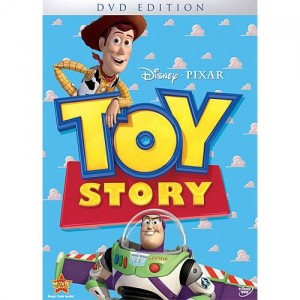
First, the obvious: Pixar is the best, most important, and most influential animation studio — if not movie studio — of the past decade and a half. 1995’s Pocahontas marked the beginning of the end of Disney Classic’s run as king of animation, the year that they handed the torch over to Pixar.
Nowadays, with no fewer than a half dozen high-profile CGI films released each year, it’s easy to forget just how jaw-dropping the original Toy Story was upon its release. There’s a shot in the opening moments where we see Woody come to life, his face moving and making very human expressions. It was stunning (almost terrifying) at a time that a computer could generate these images and make them seem so alive.
Computer animation carries a real sense of space and depth and pseudo-realism that can’t be matched by hand-drawn animation. Toy Story wisely introduced us to this new visual sensation by giving us a world intended to be a bit stiff and lifeless: Even when the toys “wake up,” they have a level of artificiality about them. They’re still wood and plastic and fabric, after all.
Because Pixar didn’t have to work with highly complex character models, they could focus their processing power on creating a vivid world. It pays off; every visual, every shot, every scene in the film immediately feels fully-formed and completely realized. Nothing is bland.
Surely Pixar was still working out kinks in its technology (*), but it was never distracting simply because the busyness and detail of each shot prevented glaring flaws. I only wish I could’ve been a few years older in 1995. I really wish I could’ve appreciated how groundbreaking and breathtaking it was at the time compared to anything else in film.
(*) I’ve seen Toy Story at least ten times, and have only detected two scenes where it’s painfully obvious this technology was imperfect. The most glaring is a shot of Spike the dog turning around to chase Woody.
Having said all of this, I’m more concerned as a film-viewer with whether the film stands the test of time rather than whether it was impressive so long ago. Thank goodness, then, that Toy Story is just as golden fifteen years after its release as it’s always been.
The film fires on so many cylinders at once. Only in my late teenage years did I start to appreciate that “cowboy vs. space ranger” cuts a little deeper than the surface. Woody’s loss of importance in Andy’s life not only serves as a metaphor of America’s loss of innocence and patience, but serves as an oblique metaphor for death (something fleshed out into even darker terrain in the sequel).
It’s also a film about the simple bond between a child and his favorite toy. Pixar has always had a knack for big ideas and unique worlds, but their films are founded on an appreciation for the small. You see this in the extraordinary detail of the visuals, but also in the purity of the characters and plots. They did this first in Toy Story.
Of course, any discussion of Toy Story would be remiss without mentioning Woody and Buzz Lightyear, two of the greatest characters in animation history. These animated characters have palpable chemistry the way two great live-action actors might.
If you don’t believe me, watch the classic “you are a toy!” scene, which is one of my top ten favorite movie scenes of all time. It also has one of my favorite movie lines — “you are a sad, strange little man, and you have my pity.” The play between Allen and Hanks is hilarious and classic (and notice how expressive Woody’s face is; it’s phenomenal for the first stab at a CGI feature). Truly, one of film’s great odd couples.
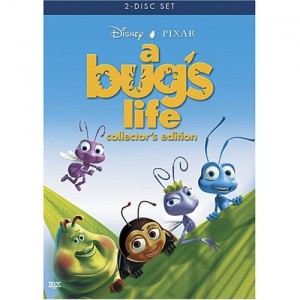
If Pixar’s sophomore effort, A Bug’s Life, feels like a little bit of a slump and one of their least memorable films, it’s just because the bar was set so high. A Bug’s Life follows a bit too closely Toy Story‘s formula of crafting a world that’s familiar but subhuman and breathing sentience and order into it — here, an ant hill instead of a toy box.
Further, A Bug’s Life plot — act 1: oddball struggles to fit in, causes trouble; act 2: oddball discovers remedy to troubles, builds confidence; act 3: oddball makes matters worse, saves the day anyways, is finally accepted — has been aped so many times (which is not entirely a bad thing) by DreamWorks and Sony Animated Pictures that it feels a bit retroactively tired.
Yet, with the possible exception of Cloudy With a Chance of Meatballs, no CGI film with this formulaic plot structure has had so much polish and perfection. I can’t think of a major flaw in A Bug’s Life other than “it’s not Toy Story” and “people stole the premise and made it into a formula.”
The broad cast of characters is colorful, perhaps even stronger than Toy Story‘s, the dialogue is consistently hilarious, and the film captures a feeling of danger and thrill in its brilliant set pieces. Overall, A Bug’s Life is a delight that crackles and inspires, even as it lacks the poignancy of most Pixar.

Toy Story vs. Toy Story 2 is a debate not unlike Godfather vs. Godfather 2. The former is classic, iconic, fun, and a piece of instant nostalgia. The second is darker, more complex, and a bit more profound. Really, there’s no right answer. It depends more on a person’s mood or preference than anything. Toy Story 2 is certainly one of the greatest film sequels of all time. It not only lived up to the original, but it sent Pixar to the stratosphere as a golden standard of film-making.
I wouldn’t blame anyone for their hesitancy towards Toy Story 2 before they saw the film. At the time, it probably seemed like the laziest move Pixar could’ve taken. I could see how the announcement of a sequel would’ve caused worry that Pixar would be plagued with predictability and sequel-itis.
Instead, the film is a mature and complex reflection of the original. It still has wit and energy and an astonishing level of detail, but it also has a somber, contemplative center. Most memorable is cowgirl Jessie’s musical number “When She Loved Me” that alters Woody’s perspective. Chronologically and thematically, that showpiece is the center of the film and the trilogy.
The central conflict of the film is a struggle of perception, like the original, but instead of one patently incorrect paradigm, two compelling and difficult perspectives are presented. They boil down to career and material prosperity (the museum) versus family and non-material success (returning to Andy’s).
While the philosophical elements of the film are compelling, the film is just as much fun as Toy Story. The script is sharp and the action is breakneck. Toy Story 2 is really the point where Pixar films took the big leap forward in terms using CGI’s lack of physical limitations as a way to realize set pieces of astonishing scope, detail, and imagination.
Finally, it’s a rewarding sequel because it has a deep reverence to the original film. Lines and scenes from Toy Story are recreated, twisted, reversed, and reapplied to Toy Story 2. It adds another layer of depth to an already-deep film. In my book, Toy Story 2 is nothing short of a masterpiece.
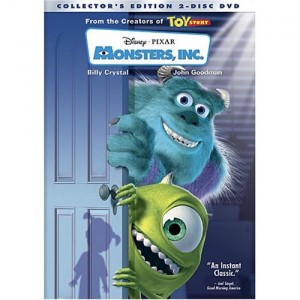
In 2001, the beloved Shrek came out, which stole some of the limelight from Monsters, Inc. Two years later, Finding Nemo, Pixar’s highest-grossing movie to date, came around. Being sandwiched like this has almost ensured that Monsters, Inc. will go down as one of Pixar’s more forgotten films. This is a shame; Monsters, Inc. remains a classic.
The most obvious strength of MI is the nonstop comedy. The visual and verbal jokes flow at a rate that seems inspired by classic Looney Tunes. The ironic set-up — scary monsters who are terrified of little kids — plays out in absolutely hilarious ways.
Billy Crystal’s hyperactive voice is conveyed visually by the antsy Mike Wazowski — one of the funnier character names in recent cinema, by the way. The contrast provided by John Goodman’s calm, deliberate Sulley, who makes Wazowski’s hysteria even funnier.
The next strength of MI is relevance and urgency. As they would famously do later in WALL•E, Pixar makes a political commentary with this film that will likely fly over the heads of youngsters, but resonates strongly to anyone mature enough to see through the metaphors. The message is this: Dealing with a power crisis — or any problem of a diminishing supply — requires a paradigm shift and a reinvention, not the invasive use of mechanical force.
Even more than the laughs and the message, the sheer amount of imagination in Monsters, Inc. is its most powerful and enduring element. Pixar’s first three films all originated from the real world. Monsters, Inc.‘s environment — while it has a few scenes in the “real world” — is pure fabrication. Seeing an invented world that seems to operate with an almost postmodern typicality is the film’s biggest pleasure.
The level of detail and development in the world is astonishing, especially after the film takes a left turn at the beginning of the third act, and the main characters are banished from their society. From there on out — and especially during the flying door climax — Monsters, Inc. is extravagantly fun and ambitious.
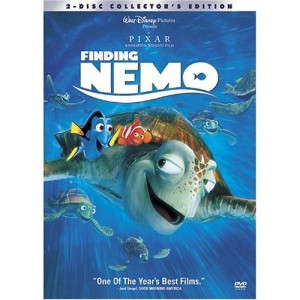
Monsters, Inc. found Pixar making a film with layers of allegorical meaning. Finding Nemo, like A Bug’s Life before it, is much more thematically direct. Where A Bug’s Life failed to achieve poignancy, though, Nemo is one of Pixar’s most powerful films — in part because of its parochial simplicity.
A lesser film might have used a lost child as a McGuffin for some zany adventures. Nemo uses the conflict as an emotional core, however — as well as a way to drive the plot. It gives every scene a sense of urgency and importance.
More than any other Pixar movie, Nemo is episodic. Especially in Marlin and Dori’s half of the plot, it’s one five-minute adventure after another. This allows the viewers to see a multitude of sea creatures and landscapes (*). By the end of the film, we really feel like we’ve been on a long, eventful quest.
(*) Finding Nemo spawned two of my favorite posters. One of them featured virtually every sea creature encountered in the film. The other is just a fantastic piece of visual design.
Every Pixar film has felt visually advanced for its time. But Nemo‘s ocean is phantasmagorical. The colors are vibrant, the scenes detailed, the characters distinct (and relatively accurate to marine biology). Seven years later, I still think Finding Nemo is the most beautiful animated film ever.
The movie is fun to just look at and listen to. It has incredible visual design, but also some of the funniest, richest sound you’ll hear in cinema. The voice acting – highlighted by Ellen DeGeneres, Willem Dafoe, Geoffrey Rush, and writer/director Andrew Stanton – is first-rate.
Only rarely does a film with visuals as stunning as these pack the level of emotional punch that Nemo does. It all adds up to a Pixar masterpiece, one of the best CGI films to date.
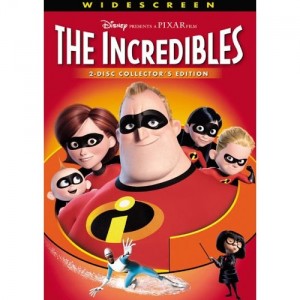
Brad Bird and Pixar are a match made in heaven. On the one hand, you have a storyteller who excels visual comedy and adventure. He composes stories at once complex and brisk. All of his work is mature and thematically rich.
On the other hand, you have an animation studio willing to give him creative free reign to use the best technology and teams in the business. The studio thrives on bold, challenging work of tremendous imagination.
The first Bird-Pixar film is a rousing success. It was longer and more adult-oriented than any Pixar film at the time of its release, and it remains one of the studio’s high points.
The Incredibles owes a lot not only to Watchmen and the Fantastic Four — the obvious inspirations for the plot — but to classic spy movies. The soul of the movie is its chases and trickery and intrigue. But, thanks to CGI, these characters can pull off moves far more dazzling than any Bond or Bourne or live-action superhero ever could. The filmmakers do a great job using animation to make the physically impossible become possible.
Like Finding Nemo, The Incredibles really feels like a long and loaded adventure. From the noir-ish prologue, to the escape from the jungle, to the climax in the big city, Incredibles is two hours jam-packed with spectacle and fun.
Still, the portrait of a most unusual family — and their superhuman takes on very human problems — is just as strong as the adventures (*). No matter how you slice The Incredibles, it’s one of Pixar’s strongest entries. It also marked The Great Leap for Pixar, the point when their films became complex and mature enough to start getting recognized as “superior cinema,” instead of “superior cinema-considering-its-target-audience.”
(*) The balance of characters and adventure are so good that I really think The Incredibles needs a sequel. It’s really the only Pixar film that has given me that hunger. The superhero premise is ripe for another story arc. Plus, the film ends on a note that essentially promises a plenitude of excitement to come for these characters. Make it happen, Bird and Pixar!

Cars seemed destined to go right; the last time John Lasseter breathed life into inanimate objects, Toy Story was born. Instead, it was a bloated, barely above-average affair that nearly imploded the Pixar recipe.
The biggest problem with Cars is its length. If it had been 90 minutes, it could’ve been brushed off as formulaic but polished diversion (like A Bug’s Life). At 116 minutes, it’s Pixar’s longest film, but it has less happening than any other Pixar work.
First, the characters are not as interesting as the ones in any other Pixar film. Mater seems to be the character we’re supposed to love because of emphasis placed on him, but he’s just not as engaging as a Mike Wazowski or a Buzz Lightyear. I think the most interesting personality here, the only one I really like, is Paul Newman’s retired racer.
Cars has a meandering pace to it. At times, it makes the film feel entitled, as if we should just be in awe of this latest Pixar film simply because it’s pretty, long, and ambitious like The Incredibles. Every part of Cars, though, is a step down from The Incredibles – the concept, the voice acting, the complexity, the visuals, the energy, etc.
It’s not to say the film is bad. It’s decent storytelling that’s polished and mostly harmless. The visuals are still very impressive. It has a few creative moments and good thoughts. The celebration of middle America feels a bit hypocritical, coming from a major conglomerate and a film apparently intended to be a franchise — but the overall message is kind-hearted and well-executed.
It’s just that the movie isn’t quite Pixar-good. It’s the only film in Pixar’s oeuvre that has felt like a let-down to date.
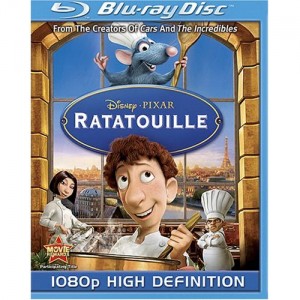 Three years after his first Pixar classic, Brad Bird returned with Ratatouille. It was a rocky development for the project — and the final product has a few scars to show for it — but Bird’s late reinvention of the project really paid off.
Three years after his first Pixar classic, Brad Bird returned with Ratatouille. It was a rocky development for the project — and the final product has a few scars to show for it — but Bird’s late reinvention of the project really paid off.
Ratatouille is jumbled and bursting with with often contradictory ideas, but the overriding accomplishment of the film is the portrayal of an unlikely artist. The chef rat Remy is perhaps the most sympathetic Pixar character since Marlin of Finding Nemo.
The reverence the film has for the “art” — in this case, fine food — is pretty stunning. The filmmakers went to Paris to study the delicacies of the area, and it shows. The food is quite appetizing for a computer graphic.
The film also dissects the psychology behind art appreciation. The critic Anton Ego plays a small but memorable role as a “villain” who eventually comes to appreciate Remy. Of course, it doesn’t hurt the character that he’s voiced by Peter O’Toole.
Speaking of the voice acting, it’s superb all around in Ratatouille. Furthermore — like The Incredibles before it — the voice acting is never distracting. There’s no voice actors (with the possible exception of O’Toole) where the character makes me think of the actor. I can’t say that for most non-Pixar CGI films. It enhances the film’s engrossing nature that the voices are barely recognizable outside of their CGI counterparts.
Like The Incredibles, Bird’s second Pixar film has a huge reverence to visual comedy at its core. That’s apparently what drew Bird to the film when its development was uncertain: the fact that he could tell a highly emotional story with a series of visual set pieces.
There’s so much happening in Ratatouille that it’s sometimes too much. Some of the subplots feel a bit excessive or overwrought. But the sum effect of the parts is one of the most moving and unique films of the 2000’s. It has its quirks, but Ratatouille might be Pixar’s best movie to date, and that’s saying something pretty strong.
 The boldest move — and maybe best move — ever made by Pixar was the stark opening act of WALL•E. Truly, the first half hour of WALL•E is a marvel of cinema operating at its most fundamental level: moving images and sounds. The cheeriness and playfulness of WALL•E the robot provides a powerful contrast to the apocalyptic setting.
The boldest move — and maybe best move — ever made by Pixar was the stark opening act of WALL•E. Truly, the first half hour of WALL•E is a marvel of cinema operating at its most fundamental level: moving images and sounds. The cheeriness and playfulness of WALL•E the robot provides a powerful contrast to the apocalyptic setting.
The best word to describe WALL•E the character is that he is animated. He’s lively, responsive, and curious despite his dingy exterior. He’s also lonely; besides a weirdly cute cockroach, he begins the movie as the only entity on the planet. So when the shiny Eve lands on Earth, he can’t help but be entranced.
He eventually departs from junkyard Earth on a quest to win Eve’s electric heart and save the fat humans. The film loses some of its momentum here. It’s still strong storytelling, but it lacks the grace of the first act. Fortunately, the movie ends with a powerful conclusion.
The film’s message — we should limit waste and materialism — is pretty clear. The near-preachiness would hamper the film if WALL•E wasn’t bursting full of adventure and romance. I did detect, though a few subtle jabs at the “green” mindset, even as the film endorses it.
Because the core of the film is a love story between two robots, the heavy-handedness of the environmental message becomes secondary. No matter what scenario he’s placed in, WALL•E is full of life. There are a few amazing scenes – such as the “dancing” scene with the fire extinguisher – that really develop the bond between two supposedly inanimate objects.
There’s also a darkness to WALL•E that really elevates it above other animated fare. The grim portrayal of humans’ post-Earth existence would be a bit disturbing if it wasn’t so bizarre and, at times, goofy. The film also takes a bit of time to contemplate WALL•E’s sentience and flirts with a very dark and depressing conclusion.
But WALL•E ends on a very moving note and has gone down as one of Pixar’s most revered films by critics and fans alike.
 Can Pixar do no wrong? Cars notwithstanding, every release has only further cemented the studio’s legacy as one of the most efficient in the biz. Nearly every film they’ve produced has felt like an instant classic, and Up is no exception.
Can Pixar do no wrong? Cars notwithstanding, every release has only further cemented the studio’s legacy as one of the most efficient in the biz. Nearly every film they’ve produced has felt like an instant classic, and Up is no exception.
Really, Up secures its greatness in the first fifteen minutes, particularly the silent montage that absolutely floored critics and fans to tears. Up establishes a powerful emotional link between viewers and curmudgeon Carl instead of using Carl’s age primarily for comedy’s sake. We understand why he’s grumpy, which makes him a very effective protagonist.
And then he gets sent on this whirlwind adventure to finish some unfinished business, and there’s no looking back. There’s a cast of colorful characters and dastardly villains. There are pitfalls and stumbles and glorious redemptions. And it all builds up to a conclusion that lends poignancy to the parenthood theme that permeates all 88 minutes of Up.
Up is pure adventure and pure heart. There are countless great set pieces, as well as the usual great voice acting and script from the Pixar wizards. Dug the dog is an immediate entrant into the pantheon of great Pixar characters, right up there with Buzz and Dori and Boo. He’s probably the funniest part of the movie alongside squawking, rainbow bird Kevin. The whole film has such a brilliant cast of characters, it’s hard to give on the edge over another.
What elevates Up into four-star and best-of-the-year status is the longing undercurrent in the film. Carl’s difficult goodbye and regret for not having given her a more exciting life or a child provides a moving contrast to the silly and fun adventures. Up is both tearjerker and barnstormer.
As always with Pixar, the film is a visual delight, bursting with detail and color. Pixar never skimps in the visual design department, which is why their movies will stand the test of time even as technology and processing power improves.
So where does Pixar go from here? They start their next era with Toy Story 3 to come out in the summer of 2010, a very appropriate way to celebrate the fifteenth anniversary of Toy Story. After that, the outlook gets a bit hazy. The studio’s expansion the next few years means the studio is able to release movies twice a year instead of once a year, with plans to alternate between sequels and non-sequels.
Monsters, Inc. and Cars have follow-ups that are officially announced, the former of which has much more promise than the latter, in my opinion. I’m still not sure why they’re ignoring The Incredibles. Perhaps they want to stick with Brad Bird if they do a sequel and he’s been difficult to lock down, which would be a reason I could accept.
Despite a new love for sequels and a more frequent release schedule, Pixar still has room for a few missteps before I cease my blind trust in them. They’re ten films into redefining animation, and have had a near-perfect average over fifteen years.





I love Disney shows, their movies are always classic.
Very interesting that we share a lot of the same opinions. I don’t really use the 4 star system, but I generally agree with your ratings, except for maybe The Incredibles, which I would put on the same level as A Bug’s Life. I’m curious to hear what you think about Pixar’s newest movies since they are considered to be significantly worse than the batch of movies you’ve reviewed here.